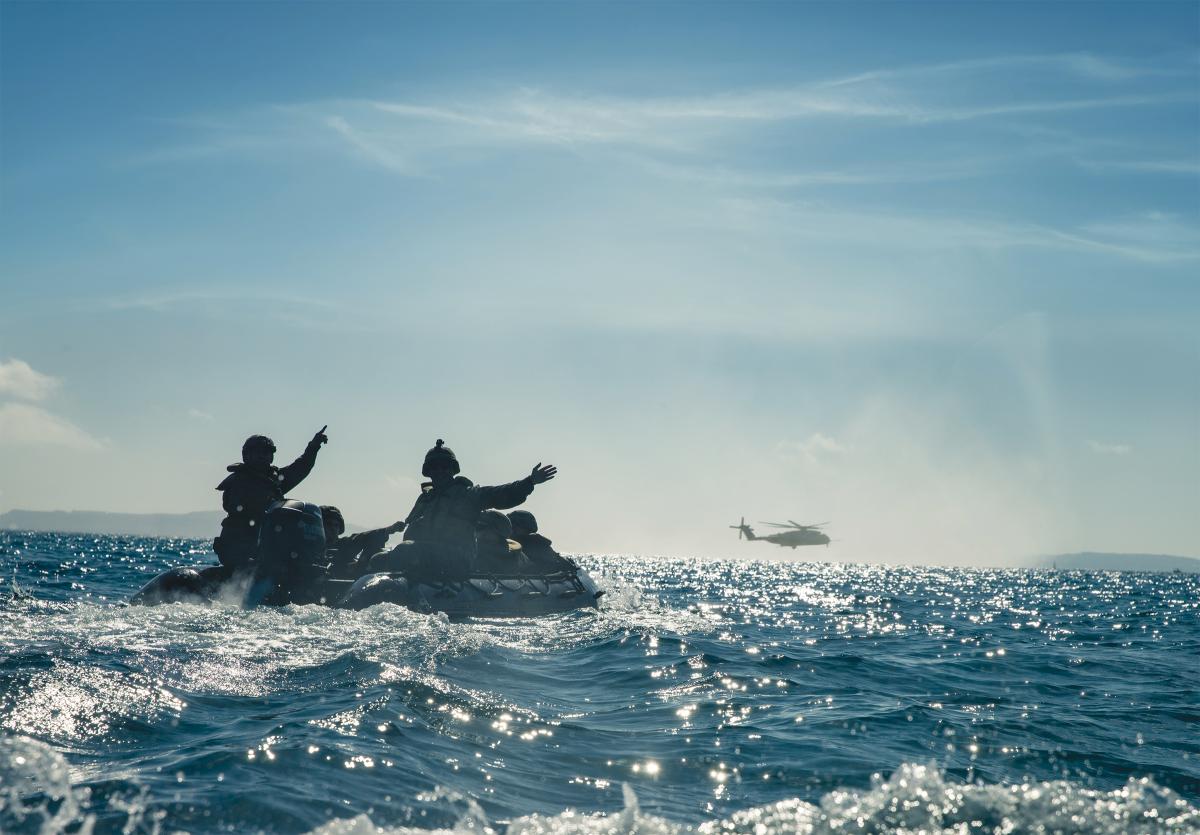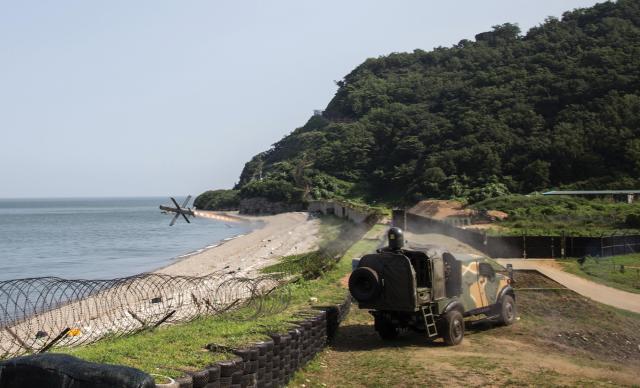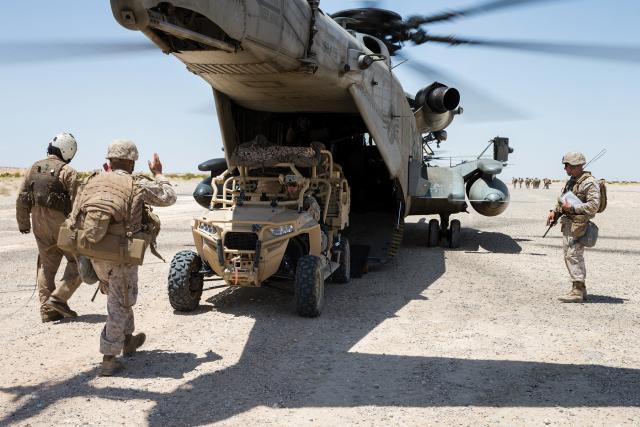In 2006, following the kidnapping of Israeli Defense Force (IDF) soldiers on Israel’s northern border with Lebanon, the IDF launched an aggressive bombing campaign that would eventually escalate into a month-long war. The ensuing conflict is notable for many reasons, from the pitfalls of “effects-based operations” to the first successful tactical employment of the C-802 antiship cruise missile (ASCM) system against a modern navy. While other sources have provided in-depth analysis of the “July War,” offering a variety of lessons learned, some of the less-intuitive lessons that follow here could inform the Navy’s and Marine Corps’ decisions in designing a new composite warfare doctrine.
Specifically, the events that took place during the 11 August drive to the Litani River offer a concise case study. Even as U.N. Security Council Resolution 1701—which eventually would bring an end to organized hostilities—was adopted, Prime Minister Ehud Olmert approved an offensive to push to the Litani River to secure at least the appearance of an IDF victory.
IDF Division 162 was tasked with seizing the critical junction town of Ghandouriyeh. To allow Israeli tanks to approach the town through the Wadi al-Saluki, IDF reconnaissance elements parachuted onto the high ground overlooking the armored force’s approach as overwatch. After being erroneously informed that the area was secure, the commander of Brigade 401 committed his 24 Merkava tanks to the wadi. Almost immediately, Hezbollah engineers collapsed a bridge to Brigade 401’s rear, cutting off the IDF’s withdrawal, and the heavily entrenched Hezbollah unit surrounding the wadi in prepared positions—supported by a tunnel network—began a barrage of antitank guided missiles and mortars. The surprising and overwhelming salvo began with a Kornet AT-14 destroying the IDF company commander’s tank, killing the entire crew. In the end, 11 of the Merkavas were hit with antitank missiles. The result was a tactical loss for the IDF, with the IDF battalion commander among the injured.1
A few general characteristics led to Hezbollah’s success:
• Exploitation of compartmentalized terrain
• Employment of forces organized for resilience against IDF air and reconnaissance efforts
• Heavy reliance on distributed lethality
Hezbollah showed that a small, operationally dispersed, and highly lethal force can exploit its battlefield environment, defeat first-rate reconnaissance, and generate catastrophic effects against advanced military systems. By the end of the war, estimates of Hezbollah causalities ran as low as 162 killed in ground fighting against the combined might of the IDF. As a show of resolve and a final act of defiance, hours before the ceasefire took effect, the organization launched an additional 250 rockets across the border at Israeli towns.2
RAFAEL
The New Composite Warfare
Marine Corps General David Berger’s Commandant’s Planning Guidance makes it clear that the service must return to its mission of contributing to naval campaigns. This direction creates an opportunity to expand the current understanding of expeditionary advanced base operations (EABO) to include new comprehensive doctrine for littoral operations task force (LOTF) composite warfare, with a commander who could exist alongside or independent of other composite warfare commanders. This composite warfare domain would include small surface combatants working with rapidly deployable Marine Corps combined arms teams to impose outsized effects on adversary naval operations. The task force would seek to match the firepower and mobility of small boats and ships with the staying power of distributed land forces, applying the concept of distributed lethality to the landward and seaward zones of the littorals.
Given the time and cost associated with developing new systems, such forces in any conflict in the next 20 years would likely have to rely principally on modestly updated versions of today’s equipment, plus some new systems nearing deployment. While F-35 aircraft sensors might eventually support expeditionary advanced bases in some capacity, continuing challenges with that aircraft’s maintenance and sustainment make its direct role in the austere conditions envisioned by this concept difficult to foresee.3
Strategy of Infection
During the July War, Hezbollah acted much as a late-stage disease does in the body, spreading itself throughout the area of operations and tying into the terrain. This allowed it to persist in the Litani River Valley despite significant IDF aerial bombardment and reconnaissance. Deployment of a LOTF should mirror this pattern. Marine Corps units will take advantage of the compartmentalized archipelagos of the South and East China Seas and will be concealed by the physical and electromagnetic (EM) clutter of maritime traffic as well. Turning multiple islands into de facto forts, with dispersed ASCM and antiaircraft missile launchers augmented by missile-capable boats, echoes Hezbollah’s wide deployment of antitank assets. Equipping a highly mobile force with a dedicated visual and EM-spectrum decoy capability would force an adversary to assume that any small island or stretch of coastline could be hiding an ASCM launcher or a unit with loitering munitions such as the Israel Aerospace Industries Harop.
This combination of ground-based sensor/shooter elements with dispersed long-range fires from small surface combatants takes advantage of a paradox within Captain Wayne Hughes’ salvo model for simulating missile exchange outcomes. The equations show that a large opposing force of smaller, less resilient shooters can sometimes defeat a force of larger, more capable hulls.4 (For more on the math of the salvo equations, see “Island Forts: Land Forces Have Value in an Air-Sea Battle,” February 2019, pp. 38–42.) An “infection” strategy takes advantage of this paradox, allowing the combined system to persist despite enemy fires. Mobile launchers and point-defense systems increase friendly force survivability by increasing the number of targets the Red force must account for. Even a small number of island-based ASCM launchers augmenting friendly missile ships and boats allows the LOTF to outstrip the average adversary surface action group. Ultimately, the LOTF should focus on maximizing the raw number of friendly force “shooters” and their geographic dispersal/distribution.
U.S. Marine Corps (Christopher Mendoza)
Defining the Littoral Operations Task Force
Getting the combination of shooter/sensor/long-range fires right would allow planners to field a resilient, capable force that could operate inside a Chinese weapons engagement zone, for example. Conceptually, it would “infect” what China calls the first island chain with distributed Navy and Marine Corps forces. The combination would require Chinese planners to conduct amphibious landings to dislodge the LOTF, foisting on the People’s Liberation Army the problem that faces U.S. planners at present. Forcing the adversary to make such an operational commitment greatly expands the duration required to achieve its military objectives, forestalling fait accompli efforts and buying time for de-escalation or, if necessary, mobilization of forces from the continental United States and allies.
To build the proper force, the standard Marine expeditionary unit (MEU) would need some redefining, with at least the following changes:
Eliminate assault amphibian armor. Landings of light infantry would be conducted by small boats, patrol craft, and medium-lift air assets. Heavy equipment would then be delivered by larger amphibious connectors to secured beachheads.
Eliminate light and heavy armor and supporting assets. Replace those with not less than three coastal missile batteries, radars, and supporting equipment.
Replace the Joint Light Tactical Vehicle and HMMWV with the Polaris MRZR all-terrain utility tactical vehicle (UTV). Weapons such as the Israeli Spike Non-Line-of-Sight missile could give them sufficient antiarmor capability.
Reduce the number of infantry companies. The MEU should deploy one small-boat-capable company and one motorized light infantry company with UTVs. These units will exist to locate, secure, and defend launcher and sensor sites. If additional capability is required, supplementary amphibious reconnaissance and force reconnaissance assets could be provided by the composite warfare commander.
Restrict air combat element (ACE) components to a section of assault-support assets and deployable Group 3 and below unmanned aerial vehicles (UAVs). This assumes the Marine Corps would continue fielding Group 1 and 2 assets to the tactical level. Experimentation with loitering munitions should guide their logical placement within either ground-based-fires units or the composite-UAV ACE.
For the Navy component, this concept would rely on small hulls such as the Mk VI patrol boat and littoral combat ship (LCS) outfitted with ASCM upgrades. In addition, the “PM” missile patrol boat concept advocated for in these pages in September 2017 should be developed.5 As the author suggested, data sharing between larger sensors, such as shore-based search radars, and smaller combatants would allow PMs to have vastly outsized effects on enemy surface vessels. This would allow even small craft to be accounted for equally with larger blue-water hulls in the salvo equations, a big improvement in lethality that would result from only a modest expansion of the naval footprint.6 As Captain Hughes has argued, this “green-water” navy would be cost effective when compared to large surface combatants and would have the potential to help the Navy realize its distributed lethality concept.7 Partnering green-water boats under the same unified command as shore-based Marine Corps elements would significantly increase this lethality.
Further experimentation will be needed to determine the minimum logistical footprint for associated ground and naval forces in the LOTF. Testing should stress the importance of self-sufficiency and resiliency. Instead of the existing family of heavy truck-based missile launchers, a system similar to the Kongsberg Naval Strike Missile shore-based launcher used by Norway, Poland, and others would be better suited to the probable operating environment. In addition, research should be aimed at producing point-defense capabilities for shore-based systems—think “SeaRAM ashore.”
Ideally, the force could be deployable from a single LPD-type amphibious assault ship. Further capability expansion (in line with visions such as “Marine Warbot Companies”) and the fielding of unmanned undersea and surface assets to the LOTF should be explored as new systems join the fleet.8
Toward the Objective
The Marine Corps has begun to take bold action, redesigning its force structure to achieve the commandant’s vision of warfighting as an integrated member of naval campaigns. Considerable experimentation and testing will be needed, but with the right resourcing and leadership, the Marine Corps is capable of saying “Aye aye, sir!” and executing much of this task today. The LOTF has the potential to act as a readily deployable naval fort. If Vice Admiral Horatio Nelson’s aphorism, “A ship’s a fool to fight a fort,” is true, then let’s force our adversaries to do something foolish in the next conflict.
1. M. Matthews, ‘We Were Caught Unprepared’: The 2006 Israeli-Hezbollah War, Long War Series Occasional Paper 26 (Fort Leavenworth, KS: U.S. Army Combined Arms Center, Combat Studies Institute Press, 2008).
2. Matthews, ‘We Were Caught Unprepared.’
3. “F-35 Joint Strike Fighter, Action Needed to Improve Reliability and Prepare for Modernization Efforts” (Government Accountability Office, April 2019).
4. CAPT Wayne Hughes and RADM Robert Girrier, USN (Ret.), Fleet Tactics and Naval Operations, 3rd ed. (Annapolis, MD: Naval Institute Press, 2018).
5. LT Alan Janigian, USN, “The Navy Needs a Modern PT Boat,” U.S. Naval Institute Proceedings 143, no. 9, (September 2017): 42–45.
6. Another possibility would be a hull similar to the “Minuteman” vessels called for in the Naval Postgraduate School’s 2016 Total Ship Systems Engineering project. See Naval Postgraduate School blog, 11 May 2017.
7. CAPT Wayne Hughes, USN (Ret.), “Build a Green-Water Fleet,” U.S. Naval Institute Proceedings 144, no. 6 (June, 2018), online.
8. Jeff Cummings, Scott Cuomo, Olivia Garard, and Noah Spataro, “Marine Warbot Companies: Where Naval Warfare, the U.S. National Defense Strategy, and Close Combat Lethality Task Force Intersect,” War on the Rocks, 28 June 2018.





